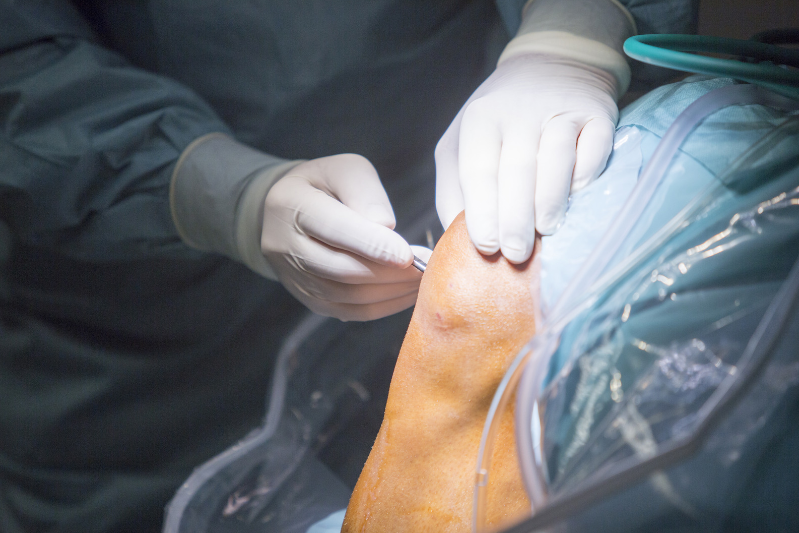Knee pain and discomfort can significantly impact daily life, limiting mobility and hindering the ability to enjoy activities. For many, knee arthroscopy emerges as a promising solution. This minimally invasive surgical procedure offers a way to diagnose and treat various knee conditions, providing relief and restoring function.
What is Knee Arthroscopy?
Knee arthroscopy is a surgical technique that allows orthopedic surgeons to examine and treat issues within the knee joint using a small camera called an arthroscope. This procedure is conducted through small incisions, minimizing trauma to the surrounding tissue and leading to faster recovery times compared to traditional open surgery. The camera transmits images to a monitor, giving the surgeon a clear view of the joint’s interior and enabling precise treatment.
Common Conditions Treated with Knee Arthroscopy
Knee arthroscopy addresses several conditions that can cause pain, swelling, and reduced mobility:
- Meniscus Tears
The meniscus serves as a cushion between the femur (thigh bone) and tibia (shin bone). A tear can occur due to injury or wear and tear, leading to pain and limited movement. Arthroscopy can either repair the torn meniscus or remove damaged portions. - ACL Injuries
The anterior cruciate ligament (ACL) is essential for maintaining knee stability, especially during sports activities. Injuries to the ACL are common and often require reconstruction. Arthroscopic techniques can effectively repair or reconstruct this critical ligament. - Cartilage Damage
Damage to the cartilage, which protects the bones in the knee joint, can result in pain and increase the risk of arthritis. Arthroscopy allows for the removal of loose cartilage fragments and smoothing of rough surfaces, helping restore joint function. - Synovitis
This condition involves inflammation of the synovial lining of the knee. Symptoms include swelling and pain. Through arthroscopy, inflamed tissue can be removed, alleviating discomfort and improving function.
Symptoms Indicating the Need for Knee Arthroscopy
Several signs may suggest that knee arthroscopy is necessary:
- Persistent Knee Pain
Chronic knee pain that doesn’t improve with conservative treatments like rest, ice, or medications may require surgical intervention. - Swelling and Stiffness
Recurring swelling and stiffness in the knee joint can hinder mobility and indicate underlying issues that may need to be addressed through surgery. - Locking or Catching
A sensation of the knee locking or catching during movement often points to structural damage within the joint, making arthroscopy a potential solution. - Instability
If the knee feels unstable or gives way during activity, this could signify a ligament injury or other issues that require surgical evaluation.
Benefits of Knee Arthroscopy Surgery
Knee arthroscopy offers several advantages that can significantly enhance a patient’s quality of life:
- Reduced Pain
One of the primary benefits is pain relief. By addressing the underlying problem, many patients experience a substantial decrease in knee pain post-surgery. - Improved Stability
Following the procedure, most individuals notice enhanced knee function and a greater range of motion, allowing for more comfortable movement. - Enhanced Function
Restoring normal joint mechanics through arthroscopy enables individuals to participate in daily activities and sports with fewer limitations. - Minimally Invasive
As a minimally invasive approach, knee arthroscopy involves smaller incisions. This results in less scarring and often quicker recovery times compared to traditional surgery.
The Knee Arthroscopy Procedure: Step by Step
Understanding what to expect during the knee arthroscopy procedure can help alleviate anxiety and prepare patients for surgery. Here’s a breakdown of the typical process:
- Pre-Operative Considerations
Before the procedure, patients undergo a thorough evaluation. Anesthesia options will be discussed, with either regional or general anesthesia typically used to ensure comfort during surgery. - Incision
The surgeon makes small incisions around the knee to insert the arthroscope and other surgical instruments. These incisions are usually less than half an inch long. - Visualization and Treatment
The arthroscope transmits images to a monitor, allowing the surgeon to accurately diagnose the issue. Once identified, the surgeon can perform necessary repairs or treatments using specialized instruments. - Closure
After addressing the problem, the surgeon closes the incisions with sutures or surgical tape. The entire procedure usually takes less than an hour.
Recovery After Knee Arthroscopy
Recovery from knee arthroscopy is generally swift and straightforward, though it can vary based on individual circumstances. Here’s what patients can expect:
- Pain Management
Mild discomfort or soreness post-surgery is common but can be effectively managed with prescribed pain medications. Patients should communicate any concerns about pain levels with their healthcare team. - Bandaging
The knee will be bandaged to protect the surgical site. Keeping the area clean and dry is essential for proper healing. - Physical Therapy
Rehabilitation exercises may be recommended to restore strength and flexibility to the knee joint. A tailored physical therapy program can greatly enhance recovery outcomes. - Returning to Activities
Many patients can resume light activities within a few days. A gradual return to normal routines, including exercise, is typically guided by the surgeon, ensuring safety and optimal recovery.
Why Choose Tec Orthopedics for Knee Arthroscopy?
At Tec Orthopedics, patient care and surgical expertise are prioritized. Here’s what sets the practice apart:
- Expert Surgeons
The team at Tec Orthopedics comprises highly skilled orthopedic specialists experienced in performing knee arthroscopy surgery. Their expertise ensures that patients receive the best possible care. - Advanced Technology
Utilizing the latest advancements in surgical techniques, Tec Orthopedics ensures optimal outcomes for knee arthroscopy procedures. State-of-the-art equipment enhances precision during surgery. - Exceptional Patient Care
Compassionate and informative care is a cornerstone of the patient experience at Tec Orthopedics. The staff is dedicated to addressing questions and concerns throughout the treatment process, ensuring a supportive environment.
Conclusion
Understanding the knee arthroscopy procedure is crucial for anyone experiencing knee pain or discomfort. This minimally invasive surgery offers a way to diagnose and treat various knee conditions, leading to improved mobility and quality of life. If you or someone you know is struggling with knee issues, consulting with a healthcare professional about the benefits of knee arthroscopy surgery may be a pivotal step toward recovery.

